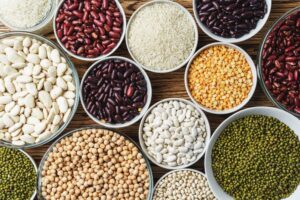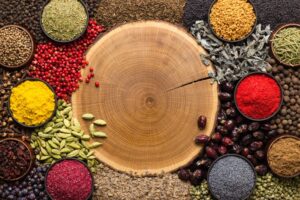Spices are more than just a way to add flavor to food; they are a connection to history, culture, and health. Throughout human civilization, spices have shaped culinary traditions, influenced economies, and contributed to the development of global cultures. Today, they are not only celebrated for their ability to transform ordinary dishes into extraordinary meals but also revered for their medicinal and health-boosting properties. This blog post explores the multifaceted role of spices and how they continue to influence the world in ways beyond just flavor.
The Flavor Revolution: Transforming Food Across Continents
Spices have the power to elevate the simplest of dishes, giving them layers of complexity and nuance. Whether it’s the bold heat of chili peppers, the earthy warmth of cumin, or the sweetness of cinnamon, spices are the cornerstone of flavor profiles across the globe. From the fiery curries of India to the tangy salsas of Mexico and the delicate spices in French cuisine, spices define the taste of different regions and cultures.
Historically, the pursuit of spices drove global exploration and trade. The famous Spice Route, which connected Europe, the Middle East, India, and China, was responsible for the exchange of goods and ideas between civilizations. Spices like black pepper, nutmeg, and cinnamon became so valuable that they were traded as currency, and their scarcity in certain regions made them symbols of wealth and prestige.
Even in modern times, spices remain essential to global cuisine. Whether used in cooking oils, marinades, or as finishing touches to dishes, spices are a way to add depth and complexity to food. The cultural impact of spices on cuisine is immeasurable, as they give each dish its unique identity, influencing local tastes, practices, and traditions.
A Cultural Exchange: The Global Impact of Spices
The cultural significance of spices extends far beyond their culinary uses. Over centuries, spices have transcended geographical boundaries, influencing not just food but also cultural practices, rituals, and identities. In many cultures, spices are intertwined with religious and spiritual rituals. For instance, in India, turmeric is considered a sacred spice used in weddings and religious ceremonies. It symbolizes purity, health, and protection, and is believed to bring prosperity and good fortune.
In the Middle East, saffron is a revered spice, not only used to flavor dishes but also to represent wealth and royalty. Its rich golden color and unique flavor have made it a symbol of luxury and status. Similarly, in the Western world, the use of spices like cinnamon and cloves during Christmas time is rooted in centuries-old traditions that reflect the seasonal celebration of warmth, family, and festivity.
The trade and migration of spices have also been crucial in shaping cultural diversity. For instance, the British Empire’s colonization of India led to the introduction of curry spices in Western kitchens. Over time, British people adapted Indian curry into their cuisine, which led to the development of the British-style curry that we recognize today. This fusion of culinary practices shows how spices have become a medium for cultural exchange, blending traditions and creating new flavors that are now enjoyed around the world.
Health Benefits: Spices as Natural Remedies
Beyond their flavor and cultural significance, many spices are prized for their health benefits. In fact, for thousands of years, spices have been used in traditional medicine to treat a variety of ailments, and modern science is increasingly confirming their powerful medicinal properties.
One of the most well-known health benefits of spices is the anti-inflammatory effect of turmeric. The active compound in turmeric, curcumin, has been shown to reduce inflammation, fight oxidative stress, and improve conditions like arthritis, heart disease, and even certain cancers. Ginger, another common spice, has long been used to relieve nausea, aid digestion, and reduce inflammation. It is particularly effective for soothing an upset stomach and alleviating symptoms of motion sickness.
Cinnamon is another spice with powerful health properties. Known for its ability to lower blood sugar levels and reduce the risk of heart disease, cinnamon is an essential addition to a health-conscious diet. It is also rich in antioxidants, which help to combat free radicals and slow the aging process.
Garlic, often used in both savory and sweet dishes, has been shown to boost the immune system, reduce blood pressure, and promote heart health. It is rich in compounds like allicin, which are responsible for its antibacterial and antiviral properties.
These examples show how spices can not only add flavor but also enhance our overall well-being. By incorporating more spices into our diet, we can enjoy the benefits of both better-tasting food and improved health.
Spices and Sustainability: Supporting Eco-Friendly Practices
As the world grapples with environmental challenges, spices are emerging as an important crop in the movement toward sustainable agriculture. Many spices are grown in small, organic farms that promote biodiversity and support local communities. Unlike large-scale monocultures, these small-scale farms focus on creating a more balanced relationship between humans and the land, ensuring that the agricultural practices are both sustainable and environmentally friendly.
In addition to promoting ecological balance, spices often require fewer resources to grow compared to other crops, making them a sustainable option for enhancing flavor in dishes. Many spice plants thrive with minimal water, making them ideal for regions that face water scarcity. Furthermore, spices like turmeric, ginger, and chili peppers are known for their resilience to harsh climates and can be cultivated in diverse environments.
Choosing sustainably sourced spices helps support small farmers, fair trade practices, and eco-friendly farming methods, allowing consumers to make a positive impact on both the environment and local communities. This makes spices not only a flavorful addition to meals but also an ethical choice for mindful consumers.
Conclusion: The Timeless Power of Spices
Spices are far more than ingredients that add taste to our food. They are part of a rich global heritage that connects cultures, enhances health, and drives economic exchange. Spices have transformed the way we cook, eat, and live, offering a link to the past while also shaping the future of food and health.
Incorporating spices into your daily diet is a simple yet powerful way to enhance the flavors of your meals, boost your health, and celebrate the rich cultural traditions that have been passed down through generations. Whether used to add warmth to a winter stew, to heal a sore throat with ginger tea, or to add vibrancy to a festive meal, spices continue to be the essence of flavor in kitchens around the world.
So next time you reach for that jar of cinnamon or sprinkle some cayenne pepper into your dish, remember that you are not just adding flavor. You are engaging in a practice that has been cherished for centuries and continues to shape the way we live and eat today.





